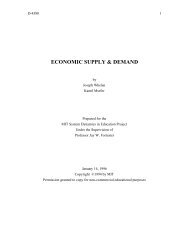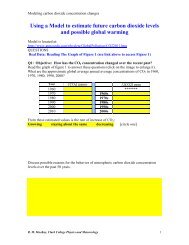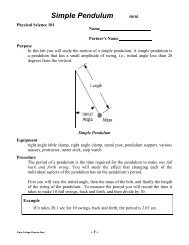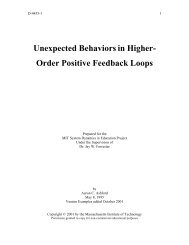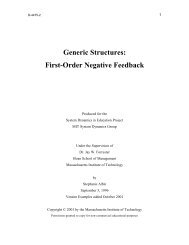Building the Fish Banks Model and Renewable Resource Depletion
Building the Fish Banks Model and Renewable Resource Depletion
Building the Fish Banks Model and Renewable Resource Depletion
You also want an ePaper? Increase the reach of your titles
YUMPU automatically turns print PDFs into web optimized ePapers that Google loves.
18<br />
D-4543-2<br />
<strong>the</strong> company can build with <strong>the</strong> fraction of <strong>the</strong> Yearly Profits being reinvested into ship<br />
building. The company will begin with 10 SHIPS <strong>and</strong> increase its fleet as long as Yearly<br />
Profits are positive. If <strong>the</strong> Catch per Ship is low, <strong>the</strong> company's Operating Costs may<br />
exceed <strong>the</strong> income from fishing, <strong>and</strong> <strong>the</strong> net profit for that year will be negative. Yearly<br />
Profits are determined by subtracting <strong>the</strong> company’s Operating Costs from <strong>the</strong> Revenues.<br />
The Operating Costs of <strong>the</strong> company depend on <strong>the</strong> number of ships in its fleet. It costs<br />
$250 per ship to operate for one year. The company sells <strong>the</strong> Total Catch per Year at<br />
$20 per fish to produce Revenues. For this model, assume that <strong>the</strong> Catch per Ship is 15<br />
fish.<br />
Two feedback loops affect <strong>the</strong> SHIPS stock. The relationship between SHIPS <strong>and</strong><br />
Revenues generates <strong>the</strong> first loop. That is, fishing with more ships leads to a larger Total<br />
Catch per Year, which in turn leads to larger Revenues <strong>and</strong> increased Yearly Profits. The<br />
increase in Yearly Profits results in an increase in <strong>the</strong> amount of money reinvested into<br />
building more ships. This is a positive feedback loop.<br />
The relationship between <strong>the</strong> number of SHIPS <strong>and</strong> Operating Costs generates <strong>the</strong><br />
second feedback loop. Increasing <strong>the</strong> number of SHIPS in operation increases Operating<br />
Costs which <strong>the</strong>n causes Yearly Profits to decrease. This decrease in profits results in a<br />
decrease in <strong>the</strong> amount of money reinvested into building more ships. This is a negative<br />
feedback loop.<br />
***Note: Since later we will be connecting this model to <strong>the</strong> <strong>Fish</strong> Population model,<br />
create Total Catch per Year as a flow. For now, leave it as an unconnected flow (with<br />
Catch per Ship <strong>and</strong> SHIPS as inputs.)<br />
3.2.2 <strong>Building</strong> <strong>the</strong> <strong>Model</strong><br />
? Create <strong>the</strong> stock SHIPS with <strong>the</strong> Ship <strong>Building</strong> Rate flowing into it.<br />
? Set <strong>the</strong> initial value of SHIPS = 10 (ships).<br />
The Ship <strong>Building</strong> Rate is <strong>the</strong> number of ships <strong>the</strong> company can build with <strong>the</strong><br />
fraction of <strong>the</strong> yearly profits being reinvested into ship building. This leads to <strong>the</strong><br />
following equation:<br />
Ship <strong>Building</strong> Rate = Yearly Profits * Fraction Invested / Ship Cost




